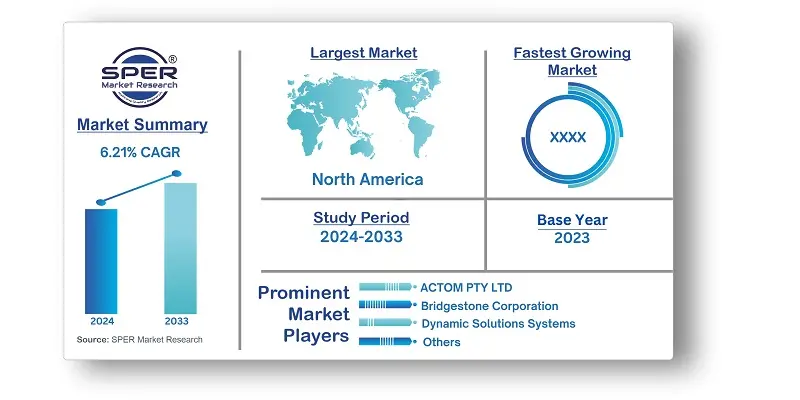
Vibration Control System Market Growth, Size, Trends, Share, Revenue, Scope and Future Outlook
Vibration Control System Market Size- By System Type, By Component, By Industry Vertical- Regional Outlook, Competitive Strategies and Segment Forecast to 2033
| Published: Mar-2024 | Report ID: SEMI2410 | Pages: 1 - 234 | Formats*: |
| Category : Semiconductor and Electronics | |||
- 2022: Launched by HyperDamping, Inc., Kinetics Noise Control Inc. (Kinetics) announced the introduction of MetaWrx, a new isolated power source. MetaWrx is perfect for suppressing both reflected vibration and transmitted noise. In gyms, dance studios, performance venues, and other establishments that use low-profile, lightweight floor build-ups, this is crucial.
- 2022: Parker Aerospace and Eviation worked together to create Alice, the world's first electric commuter plane. For Alice aircraft, Parker Aerospace will create technological systems like temperature management, electromechanical flap system, vibration and noise reduction, hydraulic power pack, and sealing solutions.


| Report Metric | Details |
| Market size available for years | 2020-2033 |
| Base year considered | 2023 |
| Forecast period | 2024-2033 |
| Segments covered | By System Type, By Component, By Industry Vertical |
| Regions covered | North America, Asia-Pacific, Latin America, Middle East & Africa and Europe |
| Companies Covered | ACTOM PTY LTD, Bridgestone Corporation, Dynamic Solutions Systems, DynaTronic Corporation Ltd., GERB, Isolation Technology Inc., MUPRO Services GmbH, Resistoflex (P) Ltd. And VSL International Ltd. |
| By System Type: |
|
| By Component: |
|
| By Industry Vertical: |
|
- Global Vibration Control System Market Size (FY’2024-FY’2033)
- Overview of Global Vibration Control System Market
- Segmentation of Global Vibration Control System Market By System Type (Automation Control, Motion Control and Vibration Control.)
- Segmentation of Global Vibration Control System Market By Component (Hardware and Software.)
- Segmentation of Global Vibration Control System Market By Industry Vertical (Automotive, Aerospace and Defence, Electronics, Healthcare and Military.)
- Statistical Snap of Global Vibration Control System Market
- Expansion Analysis of Global Vibration Control System Market
- Problems and Obstacles in Global Vibration Control System Market
- Competitive Landscape in the Global Vibration Control System Market
- Impact of COVID-19 and Demonetization on Global Vibration Control System Market
- Details on Current Investment in Global Vibration Control System Market
- Competitive Analysis of Global Vibration Control System Market
- Prominent Players in the Global Vibration Control System Market
- SWOT Analysis of Global Vibration Control System Market
- Global Vibration Control System Market Future Outlook and Projections (FY’2024-FY’2033)
- Recommendations from Analyst
1.1. Scope of the report1.2. Market segment analysis
2.1. Research data source2.1.1. Secondary Data2.1.2. Primary Data2.1.3. SPER’s internal database2.1.4. Premium insight from KOL’s2.2. Market size estimation2.2.1. Top-down and Bottom-up approach2.3. Data triangulation
4.1. Driver, Restraint, Opportunity and Challenges analysis4.1.1. Drivers4.1.2. Restraints4.1.3. Opportunities4.1.4. Challenges4.2. COVID-19 Impacts of the Global Vibration Control System Market
5.1. SWOT Analysis5.1.1. Strengths5.1.2. Weaknesses5.1.3. Opportunities5.1.4. Threats5.2. PESTEL Analysis5.2.1. Political Landscape5.2.2. Economic Landscape5.2.3. Social Landscape5.2.4. Technological Landscape5.2.5. Environmental Landscape5.2.6. Legal Landscape5.3. PORTER’s Five Forces5.3.1. Bargaining power of suppliers5.3.2. Bargaining power of buyers5.3.3. Threat of Substitute5.3.4. Threat of new entrant5.3.5. Competitive rivalry5.4. Heat Map Analysis
6.1. Global Vibration Control System Market Manufacturing Base Distribution, Sales Area, Product Type6.2. Mergers & Acquisitions, Partnerships, Product Launch, and Collaboration in Global Vibration Control System Market.
7.1. Global Vibration Control System Market Value Share and Forecast, By System Type, 2024-20337.2. Automation Control7.3. Motion Control7.4. Vibration Control
8.1. Global Vibration Control System Market Value Share and Forecast, By Component, 2024-20338.2. Hardware8.3. Software
9.1. Global Vibration Control System Market Value Share and Forecast, By Industry Vertical, 2024-20339.2. Automotive9.3. Aerospace and Defence9.4. Electronics9.5. Healthcare9.6. Military
10.1. Global Vibration Control System Market Size and Market Share
11.1. Global Vibration Control System Market Size and Market Share By System Type (2020-2026)11.2. Global Vibration Control System Market Size and Market Share By System Type (2027-2033)
12.1. Global Vibration Control System Market Size and Market Share By Component (2020-2026)12.2. Global Vibration Control System Market Size and Market Share By Component (2027-2033)
13.1. Global Vibration Control System Market Size and Market Share By Industry Vertical (2020-2026)13.2. Global Vibration Control System Market Size and Market Share By Industry Vertical (2027-2033)
14.1. Global Vibration Control System Market Size and Market Share By Region (2020-2026)14.2. Global Vibration Control System Market Size and Market Share By Region (2027-2033)14.3. Asia-Pacific14.3.1. Australia14.3.2. China14.3.3. India14.3.4. Japan14.3.5. South Korea14.3.6. Rest of Asia-Pacific14.4. Europe14.4.1. France14.4.2. Germany14.4.3. Italy14.4.4. Spain14.4.5. United Kingdom14.4.6. Rest of Europe14.5. Middle East and Africa14.5.1. Kingdom of Saudi Arabia14.5.2. United Arab Emirates14.5.3. Rest of Middle East & Africa14.6. North America14.6.1. Canada14.6.2. Mexico14.6.3. United States14.7. Latin America14.7.1. Argentina14.7.2. Brazil14.7.3. Rest of Latin America
15.1. ACTOM PTY LTD15.1.1. Company details15.1.2. Financial outlook15.1.3. Product summary15.1.4. Recent developments15.2. Bridgestone Corporation15.2.1. Company details15.2.2. Financial outlook15.2.3. Product summary15.2.4. Recent developments15.3. Dynamic Solutions Systems, Inc.15.3.1. Company details15.3.2. Financial outlook15.3.3. Product summary15.3.4. Recent developments15.4. DynaTronic Corporation Ltd.15.4.1. Company details15.4.2. Financial outlook15.4.3. Product summary15.4.4. Recent developments15.5. GERB15.5.1. Company details15.5.2. Financial outlook15.5.3. Product summary15.5.4. Recent developments15.6. Isolation Technology Inc.15.6.1. Company details15.6.2. Financial outlook15.6.3. Product summary15.6.4. Recent developments15.7. MUPRO Services GmbH15.7.1. Company details15.7.2. Financial outlook15.7.3. Product summary15.7.4. Recent developments15.8. Resistoflex (P) Ltd.15.8.1. Company details15.8.2. Financial outlook15.8.3. Product summary15.8.4. Recent developments15.9. VSL International Ltd.15.9.1. Company Details15.9.2. Financial Outlook15.9.3. Product summary15.9.4. Recent developments15.10. Others
SPER Market Research’s methodology uses great emphasis on primary research to ensure that the market intelligence insights are up to date, reliable and accurate. Primary interviews are done with players involved in each phase of a supply chain to analyze the market forecasting. The secondary research method is used to help you fully understand how the future markets and the spending patterns look likes.
The report is based on in-depth qualitative and quantitative analysis of the Product Market. The quantitative analysis involves the application of various projection and sampling techniques. The qualitative analysis involves primary interviews, surveys, and vendor briefings. The data gathered as a result of these processes are validated through experts opinion. Our research methodology entails an ideal mixture of primary and secondary initiatives.



Frequently Asked Questions About This Report
PLACE AN ORDER
Year End Discount
Sample Report
Pre-Purchase Inquiry
NEED CUSTOMIZATION?
Request CustomizationCALL OR EMAIL US
100% Secure Payment






Related Reports
Our Global Clients
Our data-driven insights have influenced the strategy of 200+ reputed companies across the globe.




















